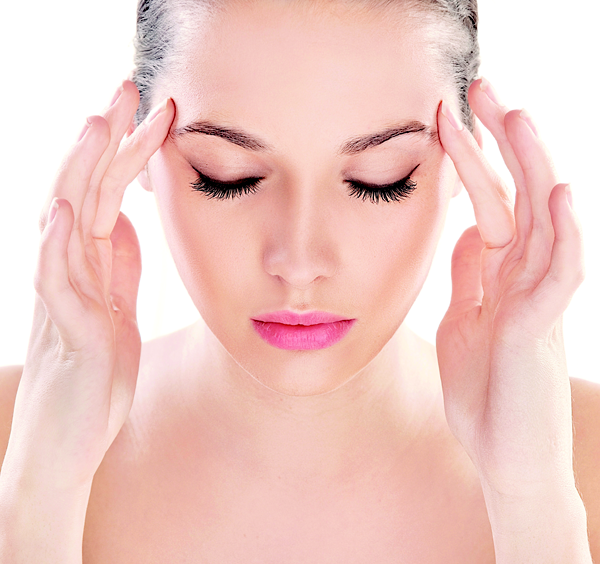
Migraines and Headaches
What is a Migraine?
A migraine is a severe headache, which can last anywhere from two hours to two days. This headache is accompanied by disturbances of vision and/or nausea, extreme pain and vomiting. Migraines affect millions of people, with roughly 75 % of them being women.
Diagnose
- Migraines are diagnosed simply through reported subjective symptoms.
- There are no medical tests, blood tests, x-rays or examination to diagnose it.

Causes
The medical cause of this condition is considered to be the release of serotonin; a biochemical substance stored in the blood platelets produced naturally in the body. Serotonin release can be triggered by a number of factors. These factors can be stress-related, food-related, or sensory-related. Additionally, migraines can be medication-related, or hormone-related. Patients often have a family history of migraine. When serotonin is released, the blood vessels constrict (narrow). As serotonin is expelled by the kidneys, its level in the brain is depleted, causing the blood vessels to dilate (expand). This dilation causes pain in the surrounding nerves, which can lead to migraines.
The glaring omission by the medical field is that the muscles of the head and neck are either fatigued or in spasm. The Neuro Muscular cause … the poor alignment of the lower jaw to the upper jaw … exists all the time … and so doesn’t get the “credit” it really deserves for causing this condition. The other point that the medical field lacks is a real solution to migraines. Correcting the Neuro Muscular imbalance … by correctly aligning the bite … takes away that major cause … allowing one to deal with stress and aggravating factors in stride. Once the bite is corrected, it stays corrected … unlike taking prescription drugs for life.
Migraine Types
There are two predominant types of migraines – common migraine and classic migraine.
The common migraine develops slowly and may be preceded by tiredness, cravings, yawning, depression, irritability and anxiousness. The common migraine usually occurs on one side of the head.
The classic migraine develops in four stages – prodrome, aura, headache and post-headache. During the prodrome stage, the person may feel fatigued. The aura stage is a slowly expanding area of blindness surrounded by a sparkling edge. In addition to the aura, the migraine sufferer may see flashing lights, colors or zig-zags of light, experience a prickly or burning sensation and/or muscle weakness on one side of the body. The third stage is the headache itself, which is usually a severe throbbing pain on one side of the head. The fourth stage is post-headache, which is characterized by exhaustion and fatigue. The classic migraine may occur on one or both sides of the head.
While these factors can contribute to a migraine episode, the biggest contributor is a poor bite relation when the lower jaw is poorly aligned with the upper jaw. This in turn results in a constant effort by the muscles of the jaw, and in turn, the muscles of the head and neck, each time the jaws are brought together. This occurs about 2000 to 3000 times each day when you swallow or chew. In turn, these muscles become fatigued or go in to spasm. Lactic acid, carbonic acid and other metabolites build up in these fatigued muscles due to increased pressure on capillaries preventing normal blood flow. This is a primary trigger of Migraines.
Symptoms
The symptoms of a migraine may include:
- Throbbing or dull aching pain on one or both sides of the head
- Nausea
- Vomiting
- Diarrhea
- Changes in how a person sees, including blurred vision or blind spots, zig-zags of light or light flashes
- Sensitivity to light, noise and odors
- Tiredness
- Confusion
- Nasal congestion
- Feeling cold or sweating
- Stiff or tender neck
- Anxious or restlessness
- Lightheaded
- Tender scalp
- Cold hands and feet
EACH one of these is also a symptom of TMD (Temporo Mandibular Dysfunction). TMD is very effectively and predictably treated with Neuro Muscular Dentistry.
Treatment Options
Treatment of migraines is directed at preventing attacks (preventive therapy) and alleviating them when they occur (abortive therapy).
Prophylactic therapy:
- eliminating the controllable triggers, such as chocolate or red wine
- improving the person’s physical, mental and emotional health by exercising, biofeedback, relaxation techniques, rest and stress reduction
- making medications to prevent the onset of an attack
The most widely used preventive drugs are beta blockers, calcium channel blockers, antidepressants, and anti-serotonin agents. Preventive medications must be taken every day, whether a headache is present or not.
Abortive therapy:
- lying in a dark quiet room with a cold compress or rag on the forehead
- massage or acupuncture
- using visualization techniques to direct blood flow away from the head putting pressure on the temples
The drug-based treatment includes medicines such as aspirin, acetaminophen, ibuprofen, naproxen, naproxen sodium, diflunisal and ergotamine tartrate.
What is glaringly lacking from the above list of treatments is a real solution. Through a scientific approach of measuring the electrical activity of the muscles of mastication (Electromyography – EMG) similar to measuring the electrical activity of the heart through EKG, the proper bite relation is diagnosed. Then by correcting the bite relation the Migraine attacks can become a thing of distant memory!
Ask your doctor are there any real solutions that would help me avoid Migraines without having to take prescription drugs for the rest of my life?
If the answer you get is less than satisfactory, then perhaps you should contact our office.
